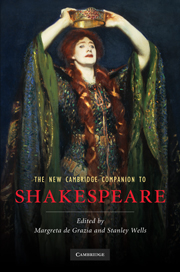Book contents
- Frontmatter
- 1 The traces of Shakespeare’s life
- 2 Shakespeare’s reading
- 3 Shakespeare’s writing: from manuscript to print
- 4 The theatre of Shakespeare’s London
- 5 The transmission of Shakespeare’s texts
- 6 Shakespeare and language
- 7 Shakespeare the poet
- 8 Shakespeare’s comedies
- 9 Shakespeare’s tragedies
- 10 Shakespeare’s English history plays
- 11 Shakespeare’s classical plays
- 12 Shakespeare’s tragicomedies
- 13 Shakespeare, religion and politics
- 14 Shakespeare and race
- 15 Shakespeare, sexuality and gender
- 16 Shakespeare on the stage
- 17 The critical reception of Shakespeare
- 18 Shakespeare and popular culture
- 19 Shakespeare and globalization
- 20 Shakespeare and media history
- 21 Shakespeare: reading on
- Index
8 - Shakespeare’s comedies
Published online by Cambridge University Press: 28 January 2011
- Frontmatter
- 1 The traces of Shakespeare’s life
- 2 Shakespeare’s reading
- 3 Shakespeare’s writing: from manuscript to print
- 4 The theatre of Shakespeare’s London
- 5 The transmission of Shakespeare’s texts
- 6 Shakespeare and language
- 7 Shakespeare the poet
- 8 Shakespeare’s comedies
- 9 Shakespeare’s tragedies
- 10 Shakespeare’s English history plays
- 11 Shakespeare’s classical plays
- 12 Shakespeare’s tragicomedies
- 13 Shakespeare, religion and politics
- 14 Shakespeare and race
- 15 Shakespeare, sexuality and gender
- 16 Shakespeare on the stage
- 17 The critical reception of Shakespeare
- 18 Shakespeare and popular culture
- 19 Shakespeare and globalization
- 20 Shakespeare and media history
- 21 Shakespeare: reading on
- Index
Summary
When the compilers of the First Folio, published in 1623, came to decide on the order in which they would print the plays, they divided them into Comedies, Histories and Tragedies. It was a bad idea. Comedy and tragedy refer to the forms of plays, history to their content. One of Shakespeare's history plays, Henry V, which sees obstacles overcome and ends with the promise of the marriage of its main character, approximates to comedy in its form. Others, such as Richard II and Richard III, are tragic in form and effect. Most of the histories make extensive use of invented material: the two parts of Henry IV include some of Shakespeare's greatest comic scenes, especially those featuring the unhistorical Sir John Falstaff. Moreover both British and Roman history lie behind some of the plays classed as tragedies, such as King Lear and Macbeth, Julius Caesar and Coriolanus.
Shakespeare's was an eclectic genius which refused to stay within the limits of traditional forms. He was a professional, writing for a popular theatre which welcomed variety of effect within plays. None of his tragedies, even King Lear, is without comedy; none of his comedies, even The Comedy of Errors or The Taming of the Shrew, lacks serious elements. And as the principal resident dramatist of the Lord Chamberlain's, later King's, Men from their founding in 1594 to the end of his career in 1613, he acknowledged a duty - which was also an invaluable stimulus to invention - to ring the changes in the nature of the plays that he contributed to the repertoire, constantly experimenting in content and form, never producing a steady, consecutively written sequence of plays in a single genre.
- Type
- Chapter
- Information
- The New Cambridge Companion to Shakespeare , pp. 105 - 120Publisher: Cambridge University PressPrint publication year: 2010

